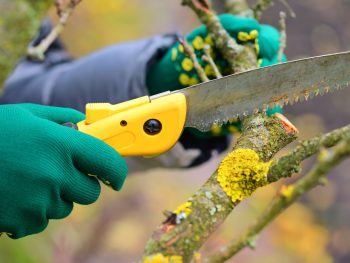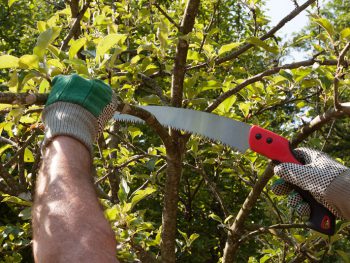
However, it doesn’t have to be as long as you have the appropriate materials to go about doing so. In this article, we will demonstrate how you can choose the best pruning saw to slice up those annoying, overgrown items to keep your garden looking clean-cut…literally!
Let’s get started!
Comparison of Top 5 Best Pruning Saws 2021
**Below, you’ll find more detailed reviews but you can also click links above to see current prices and read customer’s reviews on Amazon.
Reviews of the Best Pruning Saws
EverSaw 8.0 Folding Hand Pruning Saw
Besides being able to cut through wood, this all-purpose hand saw from EverSaw can also slice through other items like wood and bone. At a full extended length of seventeen inches, this saw is versatile for just about anything you need cut.
Pros
- This particular hand-saw brand is multi-purpose, able to be used for a variety of activities.
- It has a lock-in blade to prevent it from folding in and collapsing when you’re doing work, i.e. safety protection.
- This hand saw has an adjustable bolt between blade and handle, thereby allowing the blade to be tightened or loosened when cutting objects.
- Because of its multiple metal parts and mechanics, the EverSaw hand saw is durable and can last a long time.
Cons
- While all-purpose and durable, the hand saw might not be as sharp as expected, and might take a while to cut through thicker branches.
Bahco 396-LAP Laplander Fold Pruning Saw
(Editor’s Choice)
Useful for both beginners and professionals alike, Bahco 396-LAP Laplander Folding Saw offers plenty of quality and convenient amenities to make your next pruning project easier and safer. Sharp and durable, this particular pruning saw can be a good one to have.
Pros
- Bahco 396-LAP Laplander Folding Saw offers both a push and pull motion, thereby speeding up the process to get the work done in twice the time expected.
- This hand saw can cut through a variety of plants, including branches, bushes, dry woods, shrubs, and so forth.
- It’s useful for gardening purposes, but it can also be used for clearing the path on camping and hiking trips.
- This folding hand saw can cut through some of the thickest branches, those up to 4 inches in diameter.
Cons
- It has longer teeth, which might make it more difficult to start cutting, as well as might not be as precise.
- The hand saw might not lock well, especially if you move around a lot when working on the activity.
Fiskars 14 Foot Power-Lever Extendable Pruning Saw
As one of the pole pruning saws on this list, Fiskars’ tree pruner can extend up to heights of 14 feet, potentially even higher, so that you won’t need to get out the ladder to get to hard-to-reach places the next time you need to prune plants.
Pros
- This tree pruner is convenient for people who have difficulty reaching top spots while being able to stand firmly planted on the ground to do so.
- It cuts quickly and efficiently through tree branches.
- Fiskars’ tree pruner is flexible, which allows you to get into the nooks and crannies of the tree branches.
- It’s made from fiberglass, thus making it lightweight but also sturdy for ease of use and longevity, respectively.
Cons
- Although good for cutting out-of-reach places, this model only cuts through a maximum of 1 1/8 inches, which might not be as convenient for thicker branches at the top.
Porter-Cable PC760R 9-Inch Pruning Reciprocating Saw Blades
Specially designed to cut through pressure treated and wet lumber, Porter-Cable’s saw blades are unique in that aspect. They are also made of high carbon steel for longer durability, as well as strength when slicing through even the toughest material.
Pros
- These particular saw blades can cut up to a thickness of 8 inches, which makes it good for just about any hefty pruning activity.
- The saw blades do not dull easily, thus able to last gardening owners a long time for more future pruning projects.
- They cut through just about anything extremely quickly, which saves time and effort to go about other gardening activities.
- Porter-Cable’s reciprocating saw blades are cordless, so you don’t have to worry about lugging it everywhere just to plug it in to use.
Cons
- Although super powerful with any thickness of tree branches, these saw blades might not be very good with tree roots, as it tends to get dulled when it touches dirt near the roots themselves.
Corona RS 7265D Razor Tooth Fold Pruning Saw
For a faster and smoother cut for a variety of different tree limbs, Corona’s folding pruning saw has aimed to remain high quality for all kinds of pruning activities for over 90 years. Its razor-tooth technology has helped gardening buffs get a good pruning experience.
Pros
- This specific pruning saw is easy to use for different types of wood, from green wood to dead and frozen tree limbs.
- Able to cut down objects in half the time as other competing pruning saw brands.
- Corona’s folding pruning saw is able to cut up to thicknesses of 3 to 4 inches, so it’s not only limited to small and thin twigs.
- It can be good for long durability, up to five years or more while still remaining in solid condition.
Cons
- Corona’s pruning saw only locks in one position compared with other brands that lock in multiple positions for extra security when cutting through tree branches.
What Should You Look for in a Pruning Saw?

With that said, here’s a list of what you should take into account when choosing your pruning saw:
Size
Depending on whether you’re using the pruning saw for commercial or personal gardening, it’s necessary to consider the utility of your project, in regards to the size of the saw you want to get.
For instance, if you want to cut down large trees for cultivation (and have professional experience in doing so), then it’s best to invest in a heavy duty pruning saw. On the other hand, if you only want to tend to your small, personal garden, a smaller model is good enough.
Manual or Electric
While it may seem like getting an electric pruning saw will make the arduous task of slicing plants a lot easier, it might not necessarily be the go-to item for all things pruning.
In other words, it depends on what you’re pruning and how large the scale is for doing so. For instance, electric saws are good for getting rid of large branches and leaves all at once, but for making smaller, more refined cuts, a manual hand pruning saw is best.
Level of Protection
Like any sharp object, pruning saws can be dangerous if not handled carefully. Even when you take precautions not to hurt yourself, having protection around the saw’s blades is better than having none.
With that said, it might be good for you to invest in a folding pruning saw, which not only offers protection for your hands, but also for the blades themselves (to keep them from getting easily blunt). Plus, they can save space in the tool shed when folded in.
Height Level
Are you planning on pruning from the lower branches of the plant or from hard-to-reach places at the top? Knowing which level you’ll be cutting down unnecessary growth will help you decide what kind of pruning saw to purchase.
For example, if you’re going to prune branches from high up above, perhaps you can invest in a pole pruner, with which you can attach your pruning saw to the end of the pole. Makes cutting those high branches nothing but a cinch!
Straight or Curved Saw
Between a straight and a curved pruning saw, there’s a difference to how each of them operates in the gardening process. Knowing exactly which one you’ll need will not only help get the job done efficiently, but also save you the time and money from having to buy another one in the case it doesn’t work out.
For a straight pruning saw, you can use it to cut through objects such as saps and softer woods such as green wood; they usually are cut in a straight, repeated motion.
On the other hand, a curved pruning saw are used for bigger branches and other plants, ideally to be cut down in a single, clean slice. While useful, its blades also need to be frequently maintained.
How Much You Usually Handle
In other words, this refers to how often and how much pruning you do on a typical basis; of course, the more you do, the more likely you’ll need a pruning saw that is durable to withstand long episodes of work.
In contrast, if you tend to prune thin, light branches and leaves, then getting a smaller saw model is not a bad choice. In essence, maintaining your saw is essential to keeping it in good shape and working for a longer period of time.
Our Top Pick
Although all of these pruning saws have their good and not-so-good qualities, the winner of the roundup goes to the Bahco 396-LAP Laplander Fold Pruning Saw. Besides being a great tool for novice and advanced pruners, its push-and-pull mechanism makes it more convenient and faster to slice through just about any variety of plant objects.
It’s also versatile when it comes to gardening at home or while out camping or hiking, and is easy to carry around with you at all times. All in all, its size and functionality makes for the ideal pruning saw to invest in.

















